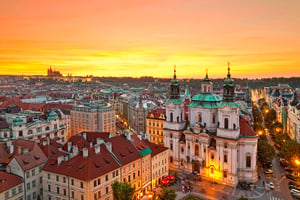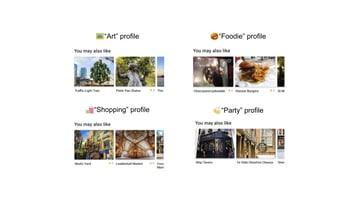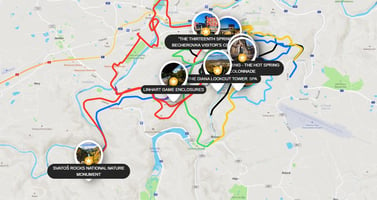In recent years, the Czech Republic has seen a surge in tourism, with visitors flocking to its...
How personalized recommendations help disperse tourists and reduce overcrowding in hotspots
Tourist hotspots worldwide are grappling with overcrowding, which affects not just the visitor experience but also local communities and the environment. Furthermore, due to this congestion many lesser-known yet equally worthy destinations remain undiscovered and economically untouched. SmartGuide helps to fix this issue by offering a platform for publishing digital audio guides and providing AI-powered personalized travel recommendations as the first travel guide app in the world. This advancement seeks to balance tourist distribution, easing the strain on popular sites and enhancing the visitor’s exploration.
Let's explore how personalized recommendations in the SmartGuide travel guide app can help disperse tourists and alleviate overcrowding in tourist hotspots.

Turning phones into personal tour guides
SmartGuide has emerged as a comprehensive companion for travelers across the globe with over 1,200 guides compiled into a single application. This world’s #1 tour guide solution stands out with its features designed for modern tourists: auto-translation in 30 languages, self-guided audio tours, offline maps, and narratives crafted by professionals that bring destinations to life alongside suggestions for top local experiences.
One of the major benefits of SmartGuide for both travelers and tourist destinations or attractions is its AI-powered guidance offering personalized travel recommendations. The app processes all its extensive content through an advanced machine-learning model developed by SmartGuide's team.
This model learned from 20 Million POIs (points of interest) to understand what the content is about and automatically categorizes content based on interests it addresses (e.g. content for kids, about history, renaissance, outdoors, art etc,). It learns from user interactions with content on the app, creating a unique profile for each traveler that reflects each traveler's preferences
The AI's personalized recommendation engine then suggests POIs and activities tailored to these interests, displayed on users' home screens, within specific destination guides, and in search results.
SmartGuide was inspired by content recommendations provided by Netflix, Spotify, or YouTube that serve relevant content for each individual user and SmartGuide decided to do the same for travel guides.
This method not only customizes the travel experience for each user but also aids in distributing tourist flows more evenly. By steering travelers towards places that align with their interests but might be less crowded, SmartGuide can play a key role in reducing overcrowding in tourism in a destination.

SmartGuide's AI recommendations reflect personalized suggestions on the home screen
Case study Prague: Easing the pressure off the city center with digital guides
Prague's city center, known for its beauty and historical significance, has long faced the issue of overcrowding. The influx of tourists flocking to the same popular spots has diminished the quality of the visitor experience and placed considerable pressure on the local infrastructure and resources.
SmartGuide helped tackle this problem head-on by digitizing paper guides and creating engaging digital content that encourages exploration beyond the over-visited city center. Through this digital audio guide platform, Prague inspired app users to spend 30% of their time exploring less visited places by sharing fascinating stories about these locations. This approach contributed to sustainable tourism efforts by distributing tourists more evenly across the city.

Prague inspired 30% of tourists out of the crowded center with SmartGuide app
These audio tours help immerse users in the story and get them to locations where destinations and attractions want them to be. The personalized recommendations provided by SmartGuide further improve this exposure. This personalization ensures that tourists are not only drawn away from congested areas but are also more likely to enjoy their discoveries thanks to tailored recommendations, leading to a more satisfying and sustainable visit.

Personalized recommendations provide sustainable visits by diverting visitors from congested spots
Case study Rome - Expanding horizons with new tours
While the charm of sites like the Forum Romanum is undeniable, the high accumulation of tourists in these areas can detract from the experience. In 2023, recognizing the potential to uplift visitors’ exposure and distribute tourist flow more evenly, SmartGuide introduced new walking and bike tours that invite exploration of Rome’s less-visited outskirts.

Dedicated walking and bike tours in the SmartGuide app spread visitors to the less popular areas way beyond the inner Rome city
This move, designed to draw interest away from the overcrowded inner city, was preceded by a year where the focus remained on central landmarks. Incorporating the new tour content together with personalized recommendations, SmartGuide quickly piqued visitors’ curiosity toward these new offerings, ensuring they discovered routes tailor-made to their preferences.
The initiative helped encourage tourists to set out into Rome's tranquil and outer districts, thus reducing the density of visitors in the central areas.

Rome before new tours added (2022) vs. Rome after new tours added (2023)
Case study Karlovy Vary - Promoting exploration beyond the Colonnade
Karlovy Vary, famous for its thermal springs and the iconic Colonnade, struggled with excessive visitor concentration in its most popular areas. To address this issue, Karlovy Vary collaborated with SmartGuide to diversify visitor encounters. Recognizing the need to appeal to an international audience, the town published four main thematic tours catering to different interests, available in five languages. This initiative was part of a broader effort that saw almost 30 tours developed, encompassing both indoor attractions, such as museums, and outdoor adventures in the natural landscapes surrounding the city.
By providing a platform that enabled the creation and publishing of these specialized tours, SmartGuide played an important role in inspiring tourists from various nationalities to venture into less frequented areas of Karlovy Vary - showcasing Karlovy Vary's vast array of hidden gems.

Carlsbad - Comparison of overall tourist activity before and after introducing tours that were thought out with an intent to spread tourists beyond the Colonnade
Case study Pilsen - Breaking language barriers
Pilsen, a city celebrated for its Pilsner Urquell brewery, observed a pattern where international visitors predominantly visited this single attraction - not surprisingly, the brewery.
While the famous brewery stands as a major draw, the city aimed to encourage a more extensive exploration of its other cultural and historical sites.
Pilsen introduced tours and informational content in multiple languages on SmartGuide. This strategy was aimed at breaking down language barriers that often limited non-Czech-speaking tourists to the most famous landmarks. By providing accessible guide content in languages like German, Italian, and Spanish, Pilsen made it easier for a diverse group of visitors to discover the city's less frequented attractions beyond the brewery.

Tours and content provided in popular foreign languages help disperse visitors from the city’s hotspot
Data analysis revealed interesting trends in visitor distribution correlating with the availability and promotion of localized guide content. For instance, there was a noticeable increase in the exploration of Pilsen's city center among German-speaking tourists, likely due to actively promoted content in German. This contrasted with Italian tourists, who, despite having content available in their language, did not show a similar spread, pointing to a lack of promotional efforts. Spanish-speaking tourists, lacking both content and promotion in their language, remained largely concentrated around the Pilsner Urquell brewery.

German visitors spread in 2023 (Content / Promotion) vs. Italian visitors spread in 2023 (Content / No promotion) vs. Spanish visitors spread in 2023 (No content / No promotion)
Case study Girona - Uncovering hidden backdrops
In Girona, a city rich in history and culture, SmartGuide spotlighted attractions beyond the usual tourist paths. Notably, this included locations used to film the popular television series "Game of Thrones." The introduction of these new tours had a clear impact on tourist behavior. Before SmartGuide's involvement, its users often overlooked Girona's as a whole, gravitating instead to well-known areas in and around Barcelona. After the introduction of guides featuring a broader range of points of interest in Girona, there was a marked increase in attention to areas previously underappreciated by tourists.

Girona before new content added (July - December 2022) vs. Girona after new content added (July - December 2023)
By comparing the visitor patterns before and after SmartGuide's introduction of these tours, it's evident that making diverse cultural and historical content available can remarkably influence tourists' exploration habits.
The role of digital guide content creation and promotion in reducing overcrowding in tourism
Creating and actively promoting digital guide content are essential actions for engaging existing users of SmartGuide. By continuously updating and marketing fresh, appealing content, this digital tour guide solution keeps its user base engaged and informed about various destinations. This strategy maintains interest among current users and helps in dispersing tourist traffic more evenly.
Similarly, targeted promotion is key in attracting new users and supporting sustainable tourism endeavors. Utilizing QR codes and NFC tags with unique activation links placed on diverse marketing materials allows SmartGuide to pinpoint precisely which channels are most effective in drawing new users. This approach gathers valuable data on user interactions and preferences, enabling destinations to refine their digital guide promotions and offerings. By understanding what resonates with tourists, destinations can implement strategic decisions that improve visitor distribution, further aiding in the reduction of overcrowding at popular sites.
Data-driven destination management through SmartGuide
SmartGuide's big data insights change the way how destinations gather and analyze information about visitor movement. Destinations receive valuable findings by comprehensively collecting quantitative data on aspects with data dashboards such as visitors' origins, demographics, language preferences, and favored sites. They are critical for understanding the current tourist landscape.
Additionally, the use of heatmaps offers a qualitative analysis, vividly showcasing where and when visitors engage most actively with a destination. Heatmaps reveal the effectiveness of specific tours in distributing visitors away from hot spots, the seasonal variances in visitor interest, and how different nationalities explore a destination.
This dual approach provides a detailed picture of tourist behaviors and trends.
The use of these data insights allows destinations to manage tourist distribution more effectively and to make informed decisions when planning future content. For instance, if data shows that a certain tour successfully encourages visitors to explore beyond overpopulated attractions, similar strategies can be replicated or expanded upon.
Furthermore, analyzing heatmap data can indicate which areas could benefit from additional content or require guidance in alternative languages to attract a broader audience. This kind of targeted approach not only amplifies the visitors’ participation by diversifying their options but also promotes a more sustainable and balanced exploration of a destination's offerings.
Conclusion
SmartGuide's approach combining personalized recommendations with comprehensive big data analytics, significantly contributes to better destination management and sustainable tourism practices.
By intelligently spreading tourist traffic across less-visited areas and providing in-depth insights into visitor behaviors, this digital audio guide platform ensures that destinations can manage their resources more effectively.
The adoption of travel guide apps and self-guided tours, as demonstrated by SmartGuide, showcases a forward-thinking strategy for promoting responsible tourism, reducing overcrowding, and developing a deeper appreciation for diverse attractions.
Are you ready to convert your destination into a model of sustainable tourism?
This project is co-financed with the state support of the Technology Agency of the Czech Republic within the Programme for Support of Applied Research and Innovation SIGMA. The project "Smart restart of safe and sustainable tourism with digital guides" is co-financed with state support from the Technology Agency of the Czech Republic under the Programme for Support of Applied Research and Innovation SIGMA. This project was funded under the National Recovery Plan from the European Recovery and Resilience Facility.
.png?width=300&height=69&name=Logo%20SmartGuide%20horizontal%20(1).png)


